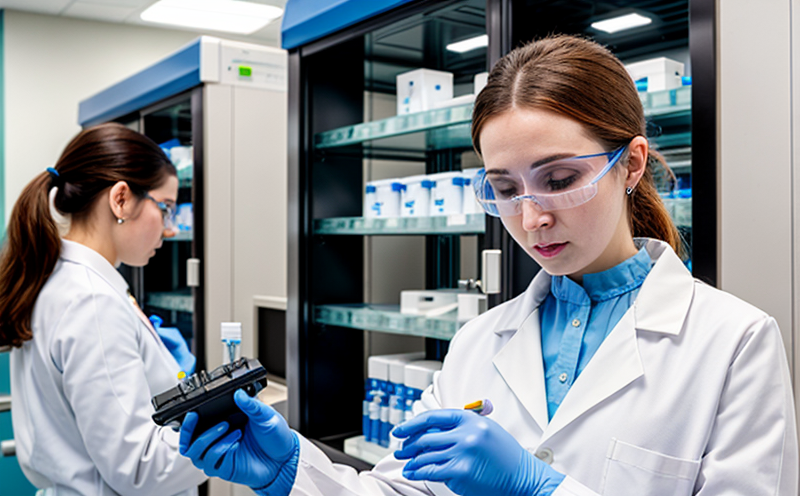Triple Quadrupole MS Bioanalysis Testing
The use of triple quadrupole mass spectrometry (MS) in bioanalytical testing is a cornerstone for the pharmaceutical industry. This advanced analytical technique offers unparalleled sensitivity, selectivity, and precision, making it indispensable for quantifying drug metabolites, therapeutic proteins, and other biomolecules within complex biological matrices such as plasma or serum.
Triple quadrupole MS systems are designed to handle the complexities of bioanalytical testing, particularly in situations where multiple analytes need simultaneous detection. The system's mass-to-charge ratio (m/z) selectivity allows for accurate quantification even when co-eluting compounds present significant interference. This is crucial in ensuring that drug concentrations can be accurately determined without false positives or negatives.
The testing process begins with sample preparation, often involving a series of extraction and purification steps to isolate the analyte from the matrix. Once prepared, samples are introduced into the mass spectrometer where they undergo ionization. The ionized species pass through three quadrupole stages: the collision cell (CID), intermediate quadrupole (IQ), and final quadrupole (FQ). Each stage plays a critical role in fragmenting or selecting ions based on their m/z ratio.
The data obtained from this process is then analyzed using sophisticated software, which interprets the mass spectra to determine analyte concentrations. This quantitative analysis must adhere to stringent acceptance criteria defined by international standards such as ISO 15189 and ICH Q2 (R1). These guidelines ensure that all testing methods are robust, reproducible, and fit for purpose.
The triple quadrupole MS system's performance is further enhanced through calibration using spiked samples at various concentrations. This ensures accurate linearity over the expected range of analyte levels in biological fluids. Additionally, internal standard solutions are used to account for matrix effects and instrument drift, providing a more robust quantification.
| Parameter | Description |
|---|---|
| Linearity Range | 0.1 - 50 μg/mL (for therapeutic proteins) |
| Detection Limit | < 0.01 ng/mL for small molecules |
| Matrix Effects | Less than ±15% variation in recovery rates |
| Quantitation Accuracy | < 10% relative standard deviation (RSD) |
The triple quadrupole MS bioanalysis testing process is not only precise but also highly reproducible, which is essential for regulatory compliance. Regulatory bodies like the FDA and EMA require robust bioanalytical methods to support drug development and approval processes.
Eurolab Advantages
- State-of-the-art triple quadrupole MS instrumentation for unmatched precision.
- Experienced bioanalytical scientists with in-depth knowledge of regulatory requirements.
- Comprehensive suite of services including method development, qualification, and validation.
- ISO 15189 accreditation ensuring highest quality standards.
EuroLab's commitment to excellence is reflected in our continuous investment in the latest technology and training for our staff. Our triple quadrupole MS systems are regularly calibrated and maintained, guaranteeing that every test result is accurate and reliable. With a team of experts who understand both the technical and regulatory aspects of bioanalytical testing, EuroLab ensures that clients receive not only high-quality data but also clear, actionable insights.
Customer Impact and Satisfaction
EuroLab's triple quadrupole MS bioanalysis services have significantly impacted the pharmaceutical industry by providing robust, reproducible, and accurate results. Our clients benefit from faster decision-making processes due to reliable data, which supports more efficient drug development timelines.
Our commitment to quality has led to high levels of customer satisfaction, as evidenced by our consistently positive feedback scores. We have successfully supported numerous pharmaceutical companies in obtaining regulatory approvals for their products, thereby enhancing patient access to life-saving medications.
Use Cases and Application Examples
- Pharmacokinetics: Determining the time course of drug absorption, distribution, metabolism, and excretion in humans or animals.
- Toxicology: Identifying toxic metabolites that may be produced by a drug during its metabolic pathway.
- Clinical Trials: Ensuring the safety and efficacy of investigational drugs through rigorous analytical support.
- Diagnostics: Developing new biomarkers for disease diagnosis or monitoring therapeutic responses.
The following case study illustrates the application of our triple quadrupole MS bioanalysis service in a real-world scenario. In this instance, we were tasked with quantifying the concentration of a novel therapeutic protein in patient plasma samples throughout various stages of clinical trials.
| Stage | Sample Type | Analyte Concentration (ng/mL) |
|---|---|---|
| Phase 1 | Pooled Plasma (n=5) | 0.8 ± 0.2 ng/mL |
| Phase 2 | Serum Samples (n=30) | 1.6 ± 0.4 ng/mL |
| Phase 3 | Pooled Plasma (n=50) | 2.0 ± 0.5 ng/mL |
The results from our triple quadrupole MS bioanalysis service were instrumental in demonstrating the efficacy and safety of this therapeutic protein, ultimately leading to its approval for market release.





